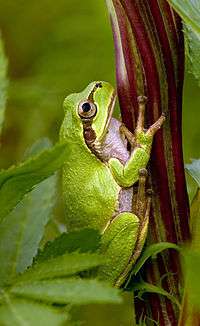Japanese tree frog
The Japanese tree frog (Dryophytes japonicus) is a species of tree frog distributed from Hokkaidō to Yakushima in Japan and from Korea along the Ussuri River to north-eastern China, northern Mongolia, and the southern parts of the Russian Far East.
| Japanese tree frog | |
|---|---|
 | |
| Scientific classification | |
| Kingdom: | Animalia |
| Phylum: | Chordata |
| Class: | Amphibia |
| Order: | Anura |
| Family: | Hylidae |
| Genus: | Dryophytes |
| Species: | D. japonicus |
| Binomial name | |
| Dryophytes japonicus (Günther, 1859) | |
| Synonyms | |
| |
The Japanese tree frog was formerly considered to be a subspecies of the European tree frog.[1] Animals from northern China, the Korean Peninsula, eastern Russia, and Mongolia have been considered to be a separate species H. ussuriensis,[2] which would make D. japonicus endemic to Japan.[1]
In 2007, a population of Japanese tree frogs was discovered in Jerusalem, Israel and possibly to have gone extinct shortly thereafter. They were originally described as a separate species, Hyla heinzsteinitzi, but based on more recent molecular analysis are now considered to have been an introduced population of Japanese tree frogs.[3]
These tree frogs are commonly found in rice paddies, and rest during the day on rice leaves and other broad-leaved vegetation. During the early evening, they are active and move to lights to catch the insects attracted to the lights.
Acting as opportunistic predators, D. japonicus mainly preys on species which are the most widely available to them, including a number of insects, such as ants, beetles, caterpillars, dipterans, and spiders.[4]
Journalist Toyohiro Akiyama carried some Japanese tree frogs with him during his trip to the Mir space station in December 1990.[5] Calling behavior of the species was used to create an algorithm for optimizing Wi-Fi networks.[6][7]
References
- Sergius Kuzmin; Irina Maslova; Masafumi Matsui; Fei Liang; Yoshio Kaneko (2017). "Dryophytes japonicus". IUCN Red List of Threatened Species. 2017: e.T55519A112714533. doi:10.2305/IUCN.UK.2017-1.RLTS.T55519A112714533.en.
- Fei, L. (1999). Atlas of Amphibians of China (in Chinese). Zhengzhou: Henan Press of Science and Technology. p. 142. ISBN 7-5349-1835-9.
- "Dryophytes japonicus (Günther, 1859) | Amphibian Species of the World". research.amnh.org. Retrieved 2019-11-29.
- Matsui, Masafumi; Hirai, Toshiaki (September 2000). "Feeding Habits of the Japanese Tree Frog, Hyla japonica, in the Reproductive Season". Zoological Science. 17 (7): 977–982. doi:10.2108/zsj.17.977. ISSN 0289-0003.
- "Soyuz TM-11: First journalist in space". Sen. 2015-06-27. Retrieved 2018-06-06.
- Plataforma SINC (17 July 2012). "Frog calls inspire a new algorithm for wireless networks". Sciencedaily.com. Retrieved 2012-07-20.
- Hernández, Hugo & Blum, Christian (2012). "Distributed graph coloring: an approach based on the calling behavior of Japanese tree frogs". Swarm Intelligence. 6 (2): 117–150. arXiv:1011.5349. doi:10.1007/s11721-012-0067-2.
External links


